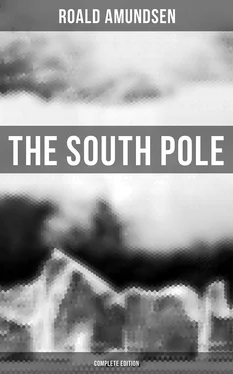We must always remember with gratitude and admiration the first sailors who steered their vessels through storms and mists, and increased our knowledge of the lands of ice in the South. People of the present day, who are so well supplied with information about the most distant parts of the earth, and have all our modern means of communication at their command, find it difficult to understand the intrepid courage that is implied by the voyages of these men.
They shaped their course toward the dark unknown, constantly exposed to being engulfed and destroyed by the vague, mysterious dangers that lay in wait for them somewhere in that dim vastness.
The beginnings were small, but by degrees much was won. One stretch of country after another was discovered and subjected to the power of man. Knowledge of the appearance of our globe became ever greater and took more definite shape. Our gratitude to these first discoverers should be profound.
And yet even to-day we hear people ask in surprise: What is the use of these voyages of exploration? What good do they do us? Little brains, I always answer to myself, have only room for thoughts of bread and butter.
The first name on the roll of discovery is that of Prince Henry of Portugal, surnamed the Navigator, who is ever to be remembered as the earliest promoter of geographical research. To his efforts was due the first crossing of the Equator, about 1470.
With Bartholomew Diaz another great step in advance was made. Sailing from Lisbon in 1487, he reached Algoa Bay, and without doubt passed the fortieth parallel on his southward voyage.
Vasco da Gama’s voyage of 1497 is too well known to need description. After him came men like Cabral and Vespucci, who increased our knowledge, and de Gonneville, who added to the romance of exploration.
We then meet with the greatest of the older explorers, Ferdinand Magellan, a Portuguese by birth, though sailing in the service of Spain. Setting out in 1519, he discovered the connection between the Atlantic and Pacific Oceans in the strait that bears his name. No one before him had penetrated so far South — to about lat. 52° S. One of his ships, the Victoria, accomplished the first circumnavigation of the world, and thus established in the popular mind the fact that the earth was really round. From that time the idea of the Antarctic regions assumed definite shape. There must be something in the South: whether land or water the future was to determine.
In 1578 we come to the renowned English seaman, Sir Francis Drake. Though he was accounted a buccaneer, we owe him honour for the geographical discoveries he made. He rounded Cape Horn and proved that Tierra del Fuego was a great group of islands and not part of an Antarctic continent, as many had thought.
The Dutchman, Dirk Gerritsz, who took part in a plundering expedition to India in 1599 by way of the Straits of Magellan, is said to have been blown out of his course after passing the straits, and to have found himself in lat. 64° S. under high land covered with snow. This has been assumed to be the South Shetland Islands, but the account of the voyage is open to doubt.
In the seventeenth century we have the discoveries of Tasman, and towards its close English adventurers reported having reached high latitudes in the South Atlantic.
The English Astronomer Royal, Halley, undertook a scientific voyage to the South in 1699 for the purpose of making magnetic observations, and met with ice in 52° S., from which latitude he returned to the north.
The Frenchman, Bouvet (1738), was the first to follow the southern ice-pack for any considerable distance, and to bring reports of the immense, flat-topped Antarctic icebergs.
In 1756 the Spanish trading-ship Leon came home and reported high, snow-covered land in lat. 55° S. to the east of Cape Horn. The probability is that this was what we now know by the name of South Georgia. The Frenchman, Marion–Dufresne, discovered, in 1772, the Marion and Crozet Islands. In the same year Joseph de Kerguélen-Trémarec — another Frenchman — reached Kerguelen Land.
This concludes the series of expeditions that I have thought it proper to class in the first group. “Antarctica,” the sixth continent itself, still lay unseen and untrodden. But human courage and intelligence were now actively stirred to lift the veil and reveal the many secrets that were concealed within the Antarctic Circle.
Captain James Cook — one of the boldest and most capable seamen the world has known — opens the series of Antarctic expeditions properly so called. The British Admiralty sent him out with orders to discover the great southern continent, or prove that it did not exist. The expedition, consisting of two ships, the Resolution and the Adventure, left Plymouth on July 13, 1772. After a short stay at Madeira it reached Cape Town on October 30. Here Cook received news of the discovery of Kerguelen and of the Marion and Crozet Islands. In the course of his voyage to the south Cook passed 300 miles to the south of the land reported by Bouvet, and thereby established the fact that the land in question — if it existed — was not continuous with the great southern continent.
On January 17, 1773, the Antarctic Circle was crossed for the first time — a memorable day in the annals of Antarctic exploration. Shortly afterwards a solid pack was encountered, and Cook was forced to return to the north. A course was laid for the newly discovered islands — Kerguelen, Marion, and the Crozets — and it was proved that they had nothing to do with the great southern land. In the course of his further voyages in Antarctic waters Cook completed the most southerly circumnavigation of the globe, and showed that there was no connection between any of the lands or islands that had been discovered and the great mysterious “Antarctica.” His highest latitude (January 30, 1774) was 71° 10’ S.
Cook’s voyages had important commercial results, as his reports of the enormous number of seals round South Georgia brought many sealers, both English and American, to those waters, and these sealers, in turn, increased the field of geographical discovery.
In 1819 the discovery of the South Shetlands by the Englishman, Captain William Smith, is to be recorded. And this discovery led to that of the Palmer Archipelago to the south of them.
The next scientific expedition to the Antarctic regions was that despatched by the Emperor Alexander I. of Russia, under the command of Captain Thaddeus von Bellingshausen. It was composed of two ships, and sailed from Cronstadt on July 15, 1819. To this expedition belongs the honour of having discovered the first land to the south of the Antarctic Circle — Peter I. Island and Alexander I. Land.
The next star in the Antarctic firmament is the British seaman, James Weddell. He made two voyages in a sealer of 160 tons, the Jane of Leith, in 1819 and 1822, being accompanied on the second occasion by the cutter Beaufoy. In February, 1823, Weddell had the satisfaction of beating Cook’s record by reaching a latitude of 74° 15’ S. in the sea now known as Weddell Sea, which in that year was clear of ice.
The English firm of shipowners, Enderby Brothers, plays a not unimportant part in Antarctic exploration. The Enderbys had carried on sealing in southern waters since 1785. They were greatly interested, not only in the commercial, but also in the scientific results of these voyages, and chose their captains accordingly. In 1830 the firm sent out John Biscoe on a sealing voyage in the Antarctic Ocean with the brig Tula and the cutter Lively. The result of this voyage was the sighting of Enderby Land in lat. 66° 25’ S., long. 49° 18’ E. In the following year Adelaide, Biscoe, and Pitt Islands, on the west coast of Graham Land were charted, and Graham Land itself was seen for the first time.
Читать дальше












